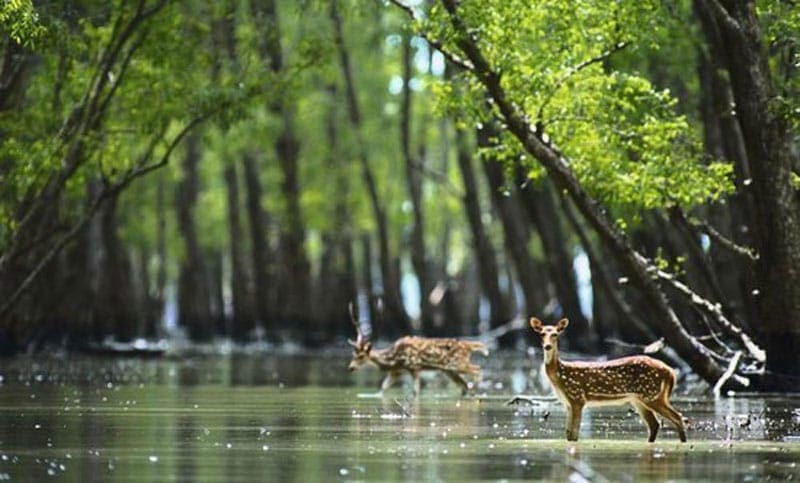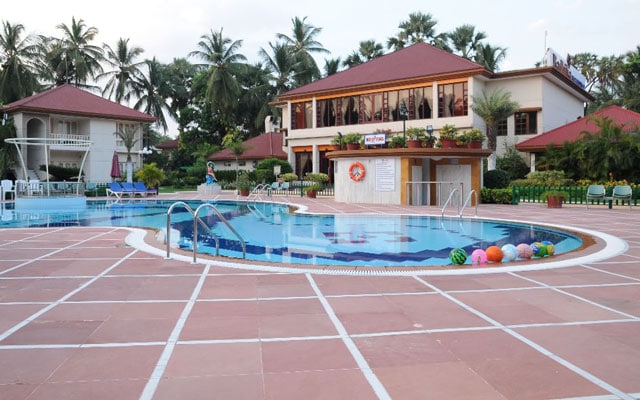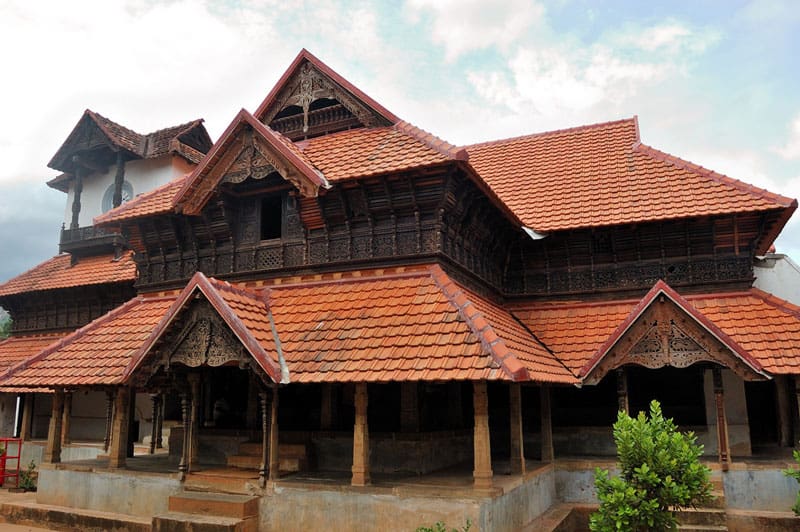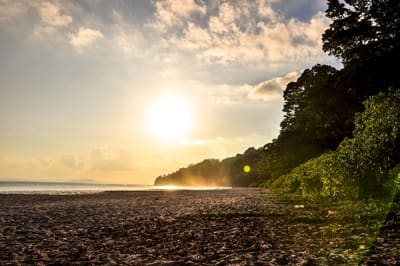Nestled in the mystical embrace of nature, the Sundarbans stands as a living testament to the marvels of biodiversity and the ingenious ways in which life adapts to its surroundings. As the world’s largest mangrove forest, the Sundarbans is situated at the confluence of the Ganges, Brahmaputra, and Meghna rivers, sprawling across the southern part of Bangladesh and the eastern edges of India’s West Bengal state. It is a UNESCO World Heritage Site, revered not only for its ecological significance but also as a haven for adventurers, wildlife enthusiasts, and seekers of serenity.
Exploring the Sundarbans means traversing a landscape sculpted by tides, discovering mesmerizing wildlife, and immersing oneself in a cultural tapestry as rich as the mudflats that nourish the region’s verdant foliage. With each turn of the tide, the forest reveals new secrets, making every visit a unique journey into an ever-changing wonderland.
Below, we present our definitive guide to the Top 5 Places to Visit in Sundarbans, meticulously curated to offer the best insights and travel tips for an unforgettable experience in this dynamic delta.
1. Sajnekhali Wildlife Sanctuary – The Heart of Sundarbans’ Biodiversity
A Haven for Rare Fauna and Avian Life
The Sajnekhali Wildlife Sanctuary is often regarded as the heart of the Sundarbans, making it one of the top places to visit in Sundarbans for nature lovers. Sprawled over approximately 362 square kilometers, this sanctuary forms a core part of the Sundarbans Biosphere Reserve and is internationally famed for birdwatching. It is the proud home of the Sajnekhali Watch Tower, offering panoramic views of the swampy grasslands and a vantage point for spotting the elusive Royal Bengal Tiger.
Key Attractions:
-
Sajnekhali Mangrove Interpretation Centre: A hub for environmental education, displaying mangrove species, aquatic life, and essential information on the delta’s unique ecosystem.
-
Sajnekhali Watch Tower: Ideal for observing wildlife in their natural habitat, especially during dawn and dusk when animal movement is highest.
-
Aviary, Crocodile Pond, and Turtle Breeding Centre: Essential stops for families and children eager to learn about the region’s reptiles and migratory birds.
Wildlife Encounters:
Sajnekhali is celebrated for its rich diversity of bird species, including kingfishers, herons, sandpipers, plovers, and the striking masked finfoot. Apart from birds, frequent sightings include spotted deer, wild boar, estuarine crocodile, water monitor lizards, and rhesus macaques. The sanctuary also protects endangered river dolphins, making it a core site for international conservation efforts.
Travel Tips:
-
The best time to visit is between November and March, when bird activity peaks.
-
Permits for entry can be obtained directly at Sajnekhali; ensure valid identification.
-
Early morning boat cruises dramatically improve chances of spotting rare wildlife.
2. Sudhanyakhali Watch Tower – Prime Spot for Tiger Sighting
Gateway to the Elusive Royal Bengal Tiger
For many, the Sundarbans conjures images of the powerful Royal Bengal Tiger weaving silently through tidal creeks. The Sudhanyakhali Watch Tower is renowned as the best place to spot tigers in the Sundarbans. Standing tall amidst dense mangroves, this tower can accommodate up to 25 visitors at a time and provides sweeping views of glistening ponds, saltwater lakes, and the riverways frequented by wild animals.
Key Attractions:
-
Watch Tower Observation: Exceptional vantage point for viewing not only tigers but also spotted deer, wild boar, crocodiles, and different bird species.
-
Water Holes: Artificial ponds attract thirsty animals, substantially increasing the likelihood of wildlife encounters.
-
Surrounding Trails: Marked with informative signboards, these trails teach visitors about local flora and the importance of mangroves.
Wildlife Encounters:
Aside from tigers, the area is alive with chital (spotted deer), wild boar, monitor lizards, and a chorus of birdcalls in the mornings and evenings. The presence of multiple water bodies draws a variety of animals within viewing range of the tower, enhancing the thrill of your Sundarbans adventure.
Travel Tips:
-
Access usually includes a boat cruise through winding creeks; always listen to your guide’s safety instructions.
-
Early mornings and afternoons are the most active times for wildlife sighting.
-
Photography enthusiasts should bring telephoto lenses for capturing scenes at a distance.
3. Dobanki Watch Tower and Canopy Walk – A Sky-high Adventure
Elevated Walkways Above the Mangroves
The Dobanki Watch Tower and its iconic Canopy Walk deliver one of the most exhilarating experiences in the Sundarbans. Elevated at 20 feet above the ground, the canopy walk is a secured mesh corridor that allows visitors to traverse the mangrove forest from a bird’s-eye perspective. It covers about half a kilometer and offers unobstructed vistas over teeming wildlife zones.
Key Attractions:
-
Canopy Walk: Safe, well-constructed, and utterly unique, this walk draws visitors from around the world for the chance to see forest life from above.
-
Watch Tower: Provides thrilling sights of spotted deer grazing, crocodiles basking in the sun, and sometimes even tigers on the prowl.
-
En-Route Mangrove Nurseries: Interpretative sites display indigenous mangrove species and showcase ongoing reforestation efforts.
Wildlife Encounters:
Dobanki is famous for prolific deer herds, langurs, wild boars, and multitude of butterflies. The vantage height also offers exceptional opportunities for birdwatchers and those seeking broader landscape photography of the delta.
Travel Tips:
-
Visits should be planned during pleasant months (October to March) to avoid humid conditions.
-
Footwear should be comfortable and suited for walking, as the canopy can become slippery during monsoon.
-
Guided excursions enhance the learning experience and ensure a safer journey.
4. Netidhopani – Land of Legends and Ancient Temples
Where Myth Meets the Mangroves
The enigmatic Netidhopani merges the thrill of wildlife adventure with the intriguing tales of history and mythology. It is most famed for the 400-year-old temple ruins and for being part of the core tiger reserve area of the Sundarbans. Netidhopani Water Tower welcomes a modest number of visitors daily, preserving the mystical ambiance that surrounds this ancient locale.
Key Attractions:
-
Netidhopani Watch Tower: Overlooks a freshwater lake, often frequented by tigers, deer, and myriad birdlife.
-
Ruins of the Netidhopani Temple: A relic rooted in local legend, believed to be linked to the tales of King Harishchandra from Indian folklore.
-
Legends and Myths: Listen to fascinating stories about the forest deities and spirits said to protect the land and people.
Wildlife Encounters:
As this area sits within the core of the tiger habitat, chances for seeing a Royal Bengal Tiger are significant. Birdwatching is also rewarding here, with regular sightings of raptors, eagles, and colorful kingfishers.
Travel Tips:
-
The area requires special permits and is not always open to all tourists year-round.
-
Guided tours are essential for both safety and insights into the site’s history.
-
It is advisable to plan morning trips for a better chance of catching wildlife action.
5. Kalas Island – Pristine Beaches and Crocodile Conservation
The Untouched Paradise of the Sundarbans
Kalas Island is celebrated for its untouched beaches, serene environment, and critical role in crocodile conservation programs. Set apart from the more crowded attractions, this island on the Bay of Bengal offers solitude, spectacular sunrise and sunset views, and glimpses of rare aquatic and terrestrial life.
Key Attractions:
-
Kalas Beach: Seldom visited, this secluded stretch of sand is perfect for those keen on peaceful reflection and photography.
-
Crocodile Breeding Centre: Core to the region’s conservation strategy, visitors can learn about the life cycle and protection of the endangered estuarine crocodile.
-
Lighthouse: Provides sweeping views of the convergence of river and sea, a sublime spot for panoramic photography.
Wildlife Encounters:
Kalas Island is refuge for olive ridley turtles, estuarine crocodiles, and a bounty of crabs and fish species. Birds are equally plentiful, as are the mesmerizing river dolphins often sighted near the creek’s mouth.
Travel Tips:
-
Plan for a full-day excursion, including a guided boat trip and packed meals.
-
Always check tidal timings as high tides can impact travel logistics.
-
Carry binoculars and avoid venturing into the water.
Extraordinary Experiences in Sundarbans – Beyond the Top 5
While these top 5 places to visit in Sundarbans constitute the region’s core highlights, the delta is brimming with vibrant local markets, lesser-known mangrove trails, and rustic villages where age-old traditions continue. Below are additional experiences to enrich your itinerary:
Bonnie Camp and Watch Tower
-
Elevated views and overnight camping near the wilderness.
-
Best for star gazing and night sounds of the forest.
Jharkhali Tiger Rescue and Ecotourism Centre
-
Rescue facility for big cats and other wildlife, informative for conservation-conscious visitors.
Pakhiralay Island
-
Hub of hospitality with a selection of homestays, boats, and travel services ideal for staging multi-day explorations.
Cultural Heritage and Local Life of the Sundarbans
Sundarban’s communities have a distinct way of life, adapted to the cycles of rivers, tides, and the rhythm of the mangroves. Village tours introduce you to honey collectors, fishermen, and farmers who weave their survival with the ebb and flow of the forests. Experience the hospitality of the Bengali people, taste local cuisine featuring fresh fish and coconut, and attend folk performances like Bonbibi drama, an ode to the forest goddess guardian.
Best Time to Visit Sundarbans
The optimal time to explore the Sundarbans is from October to March, during the winter season. The temperatures range from 10°C to 30°C, and the drop in humidity makes travel comfortable. Migratory birds arrive during this period, and wildlife is more easily spotted in the mild climate.
Monsoon (June to September) brings lush greenery and increased water levels but is best avoided due to heavy rains and possible cyclonic weather. The summer months (April to June) can be extremely humid and hot.
How to Reach the Sundarbans: Practical Travel Guide
-
By Air: The nearest airport is Netaji Subhash Chandra Bose International Airport in Kolkata, about 112km from the gateway town, Godkhali.
-
By Train: Canning is the nearest railway station, connected to Kolkata by suburban rail.
-
By Road: Regular bus services connect Kolkata to Canning and Godkhali.
-
By Water: The final leg is best traveled by motor launch or boat from Godkhali, Gosaba, or Sonakhali. Most resorts offer packages inclusive of river cruises and transfers.
Tips for a Safe and Sustainable Sundarbans Visit
-
Always hire licensed guides for insight and safety.
-
Respect local customs and wildlife regulations.
-
Wear light, breathable clothing in neutral colors.
-
Use eco-friendly products; carry back all non-biodegradable waste.
-
Strictly avoid swimming; the waters harbor crocodiles and are tidal.
-
Carry insect repellent, sunscreen, a hat, and a pair of binoculars for observing distant wildlife.
Summary Table: Top 5 Places to Visit in Sundarbans
| Place | Unique Features | Key Activities |
|---|---|---|
| Sajnekhali Sanctuary | Birdwatcher’s paradise, crocodile pond | Birding, wildlife tours |
| Sudhanyakhali Watch Tower | Best tiger sighting point, waterholes | Tiger watching, photography |
| Dobanki Canopy Walk | Elevated forest walk, deer herds, panoramic views | Canopy walk, photo safari |
| Netidhopani | Ruined temple, core tiger zone, folklore | History trail, tiger spotting |
| Kalas Island | Unspoiled beach, crocodile conservation, lighthouse | Beach stroll, eco-tourism |
Frequently Asked Questions (FAQ) for Top 5 Places to Visit in Sundarbans
-
What is the best time to visit Sundarbans?
The best time is from October to March, with cooler weather and higher chances of wildlife sightings. -
Is Sundarbans safe for tourists?
With guided cruises, proper permits, and adherence to rules, the area is safe. Always follow the advice of trained guides. -
Can we spot tigers easily in Sundarbans?
Tiger sightings are rare due to thick mangroves, but Sudhanyakhali and Netidhopani offer the best chances. -
What permits are required to visit Sundarbans?
Tourist permits can be obtained at Sajnekhali; foreign travelers may require additional documentation. -
Are there accommodations within the forest?
Yes, eco-resorts and forest lodges are available on the outskirts and islands like Pakhiralay. -
Are children allowed on boat safaris?
Yes, but ensure children are supervised at all times; life jackets are mandatory. -
Is swimming allowed in Sundarbans?
No, swimming is strictly prohibited due to strong tides and presence of crocodiles. -
What is the Sajnekhali Bird Sanctuary famous for?
It is renowned for diverse birdlife and the conservation center. -
Can I travel independently in Sundarbans?
It’s advised to use organized tours for permits, safety, and in-depth exploration. -
What unique animals can be found in Sundarbans?
Royal Bengal Tiger, estuarine crocodile, Ganges river dolphins, spotted deer, and rarities like the masked finfoot. -
Is there mobile or internet connectivity?
Connectivity is limited or unavailable deeper into the forest; prepare for digital detox. -
Do I need malaria precautions for Sundarbans?
Yes, mosquito repellent is essential; consult your doctor before travel. -
Are there local markets for souvenirs?
Yes, Gosaba and nearby villages have markets selling honey, handicrafts, and fish products. -
What’s the ideal duration for a Sundarbans trip?
A minimum of 2-3 days is recommended to fully experience boat tours and wildlife watching. -
Are guided village tours available?
Yes, immersive cultural experiences and community visits can be arranged via local tour operators.



















